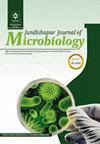Clinical Characteristics and Microbial Profiles of Paediatric Patients with Methicillin-Resistant Staphylococcus aureus Pneumonia in China
IF 0.5
4区 医学
Q4 MICROBIOLOGY
引用次数: 0
Abstract
Background: Staphylococcus aureus can cause fatal pneumonia. The evolution of bacteria and the overuse of antibiotics have enhanced the drug resistance of methicillin-resistant Staphylococcus aureus (MRSA) and methicillin-sensitive Staphylococcus aureus (MSSA). Objectives: This study aimed to recapitulate the microbiological profile and clinical characteristics of paediatric patients with MRSA. Methods: This retrospective study was conducted to investigate 1372 paediatric patients with S. aureus pneumonia from January 2017 to December 2021. Sputum specimens were collected and processed for performing bacterial culture and drug sensitivity tests. Medical records of patients were reviewed for clinical characteristics and laboratory examination results. Results: The MRSA and MSSA pneumonia mainly occurred in infants; however, comparisons of sex, age, and sampling time between patients with MRSA and MSSA pneumonia showed no significant differences (P > 0.05). The results of drug sensitivity in sputum culture revealed that all MRSA and MSSA isolates were susceptible to vancomycin, tigecycline, linezolid, teicoplanin, and ceftaroline. Methicillin-sensitive Staphylococcus aureus was completely sensitive to rifampicin and oxacillin. Methicillin-resistant Staphylococcus aureus was completely resistant to penicillin and oxacillin, while MSSA was less sensitive to penicillin. Methicillin-resistant Staphylococcus aureus and MSSA both maintained high sensitivity rates to gentamicin, sulfamethoxazole-trimethoprim, levofloxacin, and moxifloxacin, with the exception of clindamycin and erythromycin. According to our results, moreover, the sensitivity of MRSA to gentamicin and sulfamethoxazole-trimethoprim was significantly higher than that of MSSA (P < 0.05). The common symptoms of patients with S. aureus pneumonia were fever, cough, and wheezing. patients with MRSA pneumonia had significantly higher counts of white blood cells (WBCs), C-reactive protein (CRP), and procalcitonin (PCT) than patients with MSSA pneumonia (P < 0.05). Conclusions: The results of antimicrobial sensitivity test in sputum culture of MRSA and MSSA isolates can reflect the sensitivity of antibiotics and guide the use of clinical antibiotics. Infectious biomarkers can reflect the severity of infection and guide prognosis.中国儿童耐甲氧西林金黄色葡萄球菌肺炎的临床特征和微生物特征
背景:金黄色葡萄球菌可引起致命性肺炎。细菌的进化和抗生素的过度使用增强了耐甲氧西林金黄色葡萄球菌(MRSA)和甲氧西林敏感金黄色葡萄球菌(MSSA)的耐药性。目的:本研究旨在总结儿科MRSA患者的微生物特征和临床特征。方法:对2017年1月至2021年12月1372例小儿金黄色葡萄球菌肺炎患者进行回顾性研究。收集痰标本进行细菌培养和药敏试验。回顾了患者的临床特征和实验室检查结果。结果:MRSA和MSSA肺炎以婴幼儿为主;MRSA和MSSA肺炎患者的性别、年龄、采样时间比较无显著差异(P < 0.05)。痰培养药物敏感性结果显示,所有MRSA和MSSA分离株对万古霉素、替加环素、利奈唑胺、替柯planin和头孢他林敏感。甲氧西林敏感金黄色葡萄球菌对利福平和奥西林完全敏感。耐甲氧西林金黄色葡萄球菌对青霉素和oxacillin完全耐药,而MSSA对青霉素不太敏感。耐甲氧西林金黄色葡萄球菌和MSSA对庆大霉素、磺胺甲恶唑-甲氧苄啶、左氧氟沙星和莫西沙星均保持较高的敏感性,但克林霉素和红霉素除外。此外,根据我们的结果,MRSA对庆大霉素和磺胺甲恶唑-甲氧苄啶的敏感性显著高于MSSA (P < 0.05)。金黄色葡萄球菌肺炎患者的常见症状为发热、咳嗽和喘息。MRSA肺炎患者白细胞(wbc)、c反应蛋白(CRP)、降钙素原(PCT)计数明显高于MSSA肺炎患者(P < 0.05)。结论:MRSA和MSSA分离株痰培养药敏试验结果可反映抗菌药物的敏感性,指导临床抗菌药物的使用。感染生物标志物可以反映感染的严重程度,指导预后。
本文章由计算机程序翻译,如有差异,请以英文原文为准。
求助全文
约1分钟内获得全文
求助全文
来源期刊

Jundishapur Journal of Microbiology
MICROBIOLOGY-
CiteScore
1.30
自引率
0.00%
发文量
56
审稿时长
6-12 weeks
期刊介绍:
Jundishapur Journal of Microbiology, (JJM) is the official scientific Monthly publication of Ahvaz Jundishapur University of Medical Sciences. JJM is dedicated to the publication of manuscripts on topics concerning all aspects of microbiology. The topics include medical, veterinary and environmental microbiology, molecular investigations and infectious diseases. Aspects of immunology and epidemiology of infectious diseases are also considered.
 求助内容:
求助内容: 应助结果提醒方式:
应助结果提醒方式:


